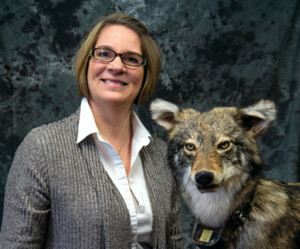 “It’s trying to understand how we create friendly landscapes for these critters to survive and thrive in and be safe, and have us be safe, too, and not have our livelihoods impacted,” said Dr. Jacqueline Frair, describing her wildlife research.
“It’s trying to understand how we create friendly landscapes for these critters to survive and thrive in and be safe, and have us be safe, too, and not have our livelihoods impacted,” said Dr. Jacqueline Frair, describing her wildlife research.
Frair, the College’s 2019-20 Exemplary Researcher, is an associate professor in ESF’s Department of Environmental and Forest Biology (EFB) and newly appointed director of the Roosevelt Wildlife Station.
She has spent countless hours building a nationally and internationally recognized wildlife program at ESF while conducting research on the same scale. She recently completed a five-year study in the Adirondacks on moose population and management.
While the moose are low in numbers, she said, they’re in high conflict (with people) because they are concentrated where timber regeneration is in progress.
“Because moose are so big they need enormous mouthfuls (of food) and they can really destroy young forests,” she said. “They strip trees, kill small regenerating trees and can be quite destructive.” In other states, trees are cut to saturate the animals with habitat so their impacts are spread out. “We can’t do that in the Adirondacks because we have restrictions on cutting.”
“We’ve got to figure out how to manage them and their impact,” she said. The state will be working on a management plan that takes Frair’s research into consideration.
Frair is also studying fishers in the Tug Hill and Adirondacks. The northern populations have been declining while the species is thriving in the state’s Southern Tier. “We’re trying to look at their productivity. We’re putting GPS collars on the females trying to find their dens and see how many kits they’re producing,” she said. Because their necks are tiny, the GPS collars are a challenge; they must be placed so they don’t impede the animal’s ability to get inside tree cavities where they nest. “They’re getting in and out, but the collars are malfunctioning,” she said. “This is our pilot year to work out the bugs.”
Frair also does research on a multitude of North American mammals, including river otters, white-tailed deer, coyotes and wolves, as well as jaguars in South America, peccary in Paraguay, giant tortoises in the Galapagos, and Amur tigers and leopards in Russia. She also studies large cats and human conflict in Kenya and Tanzania.
Animal movement is the common thread that runs through the research, she said. “Because they’re all large or wide-ranging animals they’re in a lot of competition with people because they need the land we’re occupying so it’s all about that conflict and trying to balance their needs with ours.”
Frair has served as a science adviser to the New York State Fish and Wildlife Management Advisory Board since 2006. She has worked with the New York Department of Environmental Conservation (DEC) Wildlife Partners and secured multiple umbrella omnibus DEC agreements of more than $9 million that go toward supporting EFB’s wildlife program.


